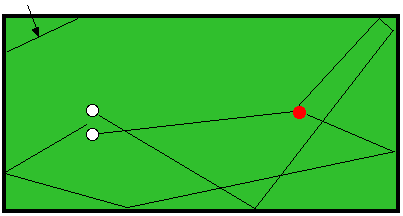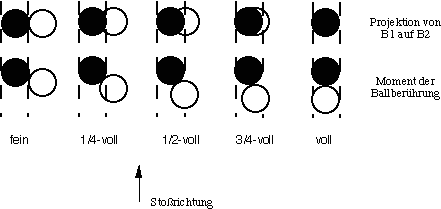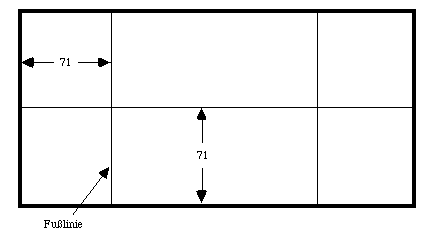General rules:
What all disciplines have in common is that two players should achieve as many correct carom positions as possible. Carom means that B1 touches both B2 and B3. The order of the touches is irrelevant. What is also correct is determined by additional conditions depending on the discipline.
Starting ball:
The balls always start the game in the same position (Fig. 2). Player 1 can choose whether B1 is placed on the right or left kick-off point. The red ball must be played first; the illustration shows the usual solution, but not the only one (Ferdi knows what I mean ;-)).
Corner swab (of course there are 4x):

Fig. 2
Inning:
In a game, an inning is the duration of a visit to the table; it ends when a mistake is made, i.e. the carom is missed.
Ball 1:
The ball (B1) that is played with the cue. The starter of the game plays the pure white ball, the player who has the second shot plays the point ball or the yellow ball as ball 1. This applies for the entire duration of the game.
Ball 2:
The first ball played, i.e. the ball that B1 touches first. This can be the opponent’s white ball or the red ball.
Ball 3:
The ball that B1 hits last (if the carom works…).
Balls:
Formerly made of ivory, now made of synthetic resin with a diameter of 61.5 mm (see B1 – B3). There are two white balls and one red . To distinguish them, one of the white balls has dots (=dot ball). In a so-called television set, the dot ball is replaced by a yellow ball .



Amount of ball:
Describes where B1 hits B2 (see meeting point). The fuller B1 hits B2, the greater the amount of ball (Fig. 5).

Fig. 5
Cushion:
Rubber covered with cloth, which limits the playing surface of the billiard and serves to reflect the balls as elastically as possible.
Bandenentscheid:
At the start of a game, both players simultaneously kick a white ball from the foot line (see Fig. 3) in the direction of the opposite short cushion and try to place it as close as possible to the short cushion. The player who manages to reduce the distance between the ball and the short cushion decides who starts the game (=player 1).
Billard:
- All games with balls and cues that are played on a pool table. There are two essentially different types of billiards game:
- a) Hole billiards: This involves sinking balls into 6 holes according to various rules. The best-known examples are pool and snooker.
- b) Carom billiards: The aim here is to achieve carom shots in accordance with various rules that depend on the discipline (see rules).
- Flat, rectangular table with a raised side and elasticated inner edge (=board) on which balls are played; in carom billiards, the table has no holes. The playing surface (=cloth) has a ratio of the long side to the short side of 2:1. The so-called match billiard has the (internal) dimensions 2.84 m x 1.42 m. The dimensions of the small billiard are 2.10 m x 1.05 m. Tournament tables are heated, which significantly improves the running characteristics.
Trestle:
Support for the front end of the cue, preferably by gripping the cue shaft with the handle. The cue rack should be as stable as possible, so at least three fingers – or two fingers plus the ball of the thumb – should be placed on the board (= billiard table) (Fig. 4).

Abb. 4
Trestle hand:
The hand that guides the cue, the left hand for right-handed players.
Cadre L/N:
There are cadre disciplines graded according to difficulty and playing area. What they have in common is that they only allow a limited number (N) of carom positions within a rectangle, N is given as a number after the slash (N=1 or N=2). The size of the rectangle in centimetres is given as a number before the slash (L). The larger the rectangle (L) and the smaller N, the more difficult the cadre discipline. The cadre rules prevent a series of points from being scored very easily when the balls are close together (American series). Example cadre 71/2 (match billiards): Here, chalk lines are drawn parallel to the boards at 71 cm intervals. This creates six fields on the playing surface (Fig. 3). If 2 points are scored in a square (i.e. B2 and B3 were inside the square before the carom positions), then B2 or B3 must leave the square in which the carom was played.

Abb. 3
Dessin:
The intended solution of a figure, i.e. the planned running lines of B1 and B2, rarely also B3. A good design improves the position of the balls and makes it easier to score more points.
Distance:
–> Goal of Game.
Discipline:
There are the following disciplines in carom (in ascending order of difficulty):
Free game, cadre (35/2, 35/1, 52/2, 52/1, 47/2, 47/1, 71/2, 71/1), one-band, three-band.
Twist:
Any rotation around an axis parallel to the table, i.e. in the direction of impact. A trailing wheel has a forward twist, a trailing wheel has a rotation that acts in the opposite direction of the impact.
Three Cushion:
For a point to count, B1 must touch at least three boards before hitting B3. This is the discipline with the highest level of difficulty. World-class players have a (general) average of around 1.5.
Average:
Quotient of the number of points and the number of shots required. General average (GD) means the averaged average over a longer period of time, such as a tournament or a season.
Corner swab:
In the free game, the four corners are specially marked. In each of the corners (=corners, see Fig. 2), only a maximum of 2 caroms may be scored before at least B2 or B3 must leave the corners. The purpose of this rule is equivalent to that of the cadre rules: you cannot score as many caroms as you like in the smallest possible space.
Spin:
Rotation of a ball around an axis perpendicular to the table top. Sometimes forward and backward spin are also referred to as effet. To avoid linguistic confusion, a distinction is made here between twist and Spin.
One Cushion:
For a point to count, B1 must touch at least one rail before hitting B3.
Ferrule:
Plastic connection between cue wood and leather ( Fig. 1). The diameter, also for the leather, is 10-13 mm.

Fig. 1
Free Game:
There are no additional conditions as to when a carom counts.
World-class players have a GD>50, games with 100 cuts are quite common (cf. three cushion).
Grip hand:
She holds the back end of the cue (the right hand for right-handed players). It should stand vertically downwards and hold the cue loosely with the four fingers from below, the thumb grips from above. The wrist should remain stiff during the stroke, the stroke is essentially made from the forearm. If the grip is too far in front of or behind the centre of gravity of the cue, the risk of pumping (up and down movement of the cue tip) is increased. This leads to a (naturally undesirable!) deviation from the planned point of impact.
Grip width:
The distance between the support and the grip hand. The higher the desired speed, the greater the grip width should be. For 80% of strokes, the grip hand should grip the cue about half to a full hand’s width behind the centre of gravity.
Carom:
- Collective term for all disciplines on a billiard without holes,
- any contact between two balls, in particular
- the correct meeting of B2 and B3 by B1. Such a carom entitles the player to continue playing and scores one point.
Posture:
It is favourable if the kick is not made from the upper arm or wrist, but only from the forearm. In order to allow maximum freedom of movement with minimal up and down movement, the forearm should point approximately vertically downwards at the start of the kick (grip hand) and form a right angle with the upper arm (Fig. 6).

Fig. 6
For accurate aiming, the tip of the nose should be above the cue if possible (if you aim with one eye, this applies to the corresponding eye). If the tip of the right foot (the left foot for left-handers) is also directly under the cue, the position is optimal, as this means that the cue, eyes and base (= right foot) form a single line in the direction of the target (Fig. 7).

Fig. 7
The position of the feet should be adapted to the stroke. A higher desired speed requires more ‘run-up’, therefore, in addition to the grip width, the distance of the right foot from the trestle should also be increased. In general, the body position should be comfortable and stable.
Leather:
The end of the cue made from the material of the same name. Its grip should be guaranteed by regular chalking and allow Effet and spin to be transferred to B1. In addition to a certain elasticity, the shape of the leather plays a decisive role in its usability. It should be evenly rounded and smooth at the ferrule, so that it does not protrude sideways under any circumstances (see Fig. 1).
Follow-up push:
The last inning of player 2; it starts with the initial ball. This ensures that both players have had the same number of attempts to reach the game goal and also the same starting position at least once.
Game:
A game is finished either when
- one of the players has scored the required number of points and both players have played the same number of shots, or
- both players have played the maximum agreed number of shots without scoring the points available, or
- one player has won the required number of sets.
Game goal or Match objective:
The number of points that must be scored to end a match prematurely, in the set system also the number of sets won.
Points:
Number of correct caroms scored.
Cue:
Tapered wooden stick (other materials are the exception) with which the ball (B1) is struck, i.e. the desired direction, speed and rotation are transmitted. The cue should be as straight as possible (a simple test for this is rolling on a billiard table). The used wood may have a few years on it so that it no longer works. The cue should weigh between 450 g and 550 g and consist of a maximum of two parts. The quality of the cue is also largely determined by the appearance of the leather.
Set:
- The three balls as a whole,
- The three balls as a whole,
- see game material,
- one round in the set system, just like in tennis,
- –> Rules.
Record system
Here, a number of sets won that are sufficient to win the match is agreed as the match objective, as well as the number of points and shots per set. There is only one extra shot in the first shot of each set.
Beak:
Distance from the buck to ball 1. This is one of the parameters for the shot, as different sized beaks enable different distances to be achieved: The larger the beak, the higher the maximum kick speed, but the larger the beak, the higher the error rate for hitting the planned kick point.
Player 1:
Player 1 begins the game with the starting ball. His ball is the pure white ball for the entire game.
Player 2:
This player has the follow-up shot. He plays with the dot ball or the yellow ball.
Impact point:
This is where the tip of the cue (= the leather) meets B1. Sometimes this point is also called the nicking point.
Direction of impact:
Direction of impact. In this direction, B1 runs. The direction of impact runs parallel to the target direction; in the case of a central impact, both are identical (Fig. 8).

Fig. 8
Speed:
The speed of B1, before it meets B2, is essentially determined by four parameters.
- The impact force (= speed of the cue at the moment of contact with the ball),
- the grip width,
- the beak,
- the foot position.
These parameters are only valid until the first collision. After the collision of B1 with B2, the point at which B2 is hit determines the tempo of B1: the more B2 is hit, the more the tempo of B1 decreases and that of B2 increases (-> speed distribution).
Speed distribution:
This refers to the ratio of the speeds of B1 and B2 after the carom. It mainly depends on the point of impact, i.e. the amount of ball. Three extreme cases, which are immediately obvious and from which all other cases can be derived, are sufficient for consideration:
- B1 does not hit B2. ==> Tempo (B1) remains the same, tempo (B2) remains zero (trivial?!?).
- B1 does not hit B2. ==> Tempo (B1) remains the same, tempo (B2) remains zero (trivial?!?).
- B1 hits B2 100% (= 1/1) full. ==> Tempo (B1) becomes zero after the pile-up, tempo (B2) is equal to tempo (B1 before the carom).
- B1 hits B2 50% (= half) full. ==> B1 and B2 share the energy B1 had before the collision with B2 <==> Tempo (B1) ‰ Tempo (B2).
All three cases require a B1 without twist.
Meeting point:
Here B1 meets B2.
Cloth:
Usually green fabric with which the table top is evenly and tightly covered. This fabric is either worsted yarn or fine woollen cloth. It should be vacuumed regularly to maintain its running properties for as long as possible.
Grip loop:
The index finger and thumb, more rarely the index finger and middle finger, form a loop that enables the cue to be guided as precisely as possible (see Fig. 4). On the other hand, the loop should be large enough so that the friction on the cue shaft does not interfere. Only in exceptional cases should the cue not be formed with a wrap (tight play, some trailing cues).
(Pre)swinging:
Swinging refers to the preparatory swinging movement with the cue. In addition to the swing, it mainly serves to mobilise the feeling of movement for the planned shot. The swing should therefore always be performed in the same way as the shot. For long distances (= higher speed of B1), for example, you should swing faster than for short distances. To largely automate the swinging process, it makes sense to always perform the same number of preliminary swings in succession as smoothly as possible.
Target direction:
Intended extension of the cue to a point. If B1 is hit in the centre, it is identical to the direction of impact.
© Jörg Unger (created in March 1993, at that time still at the  BAB in Berlin).
BAB in Berlin).
Some of the pictures are modelled on the first of two very good books by K.H. Stingl (unfortunately only available second-hand).
Translated with the support of deepl.
Please send comments and suggestions to joerg.unger@hamburg.de